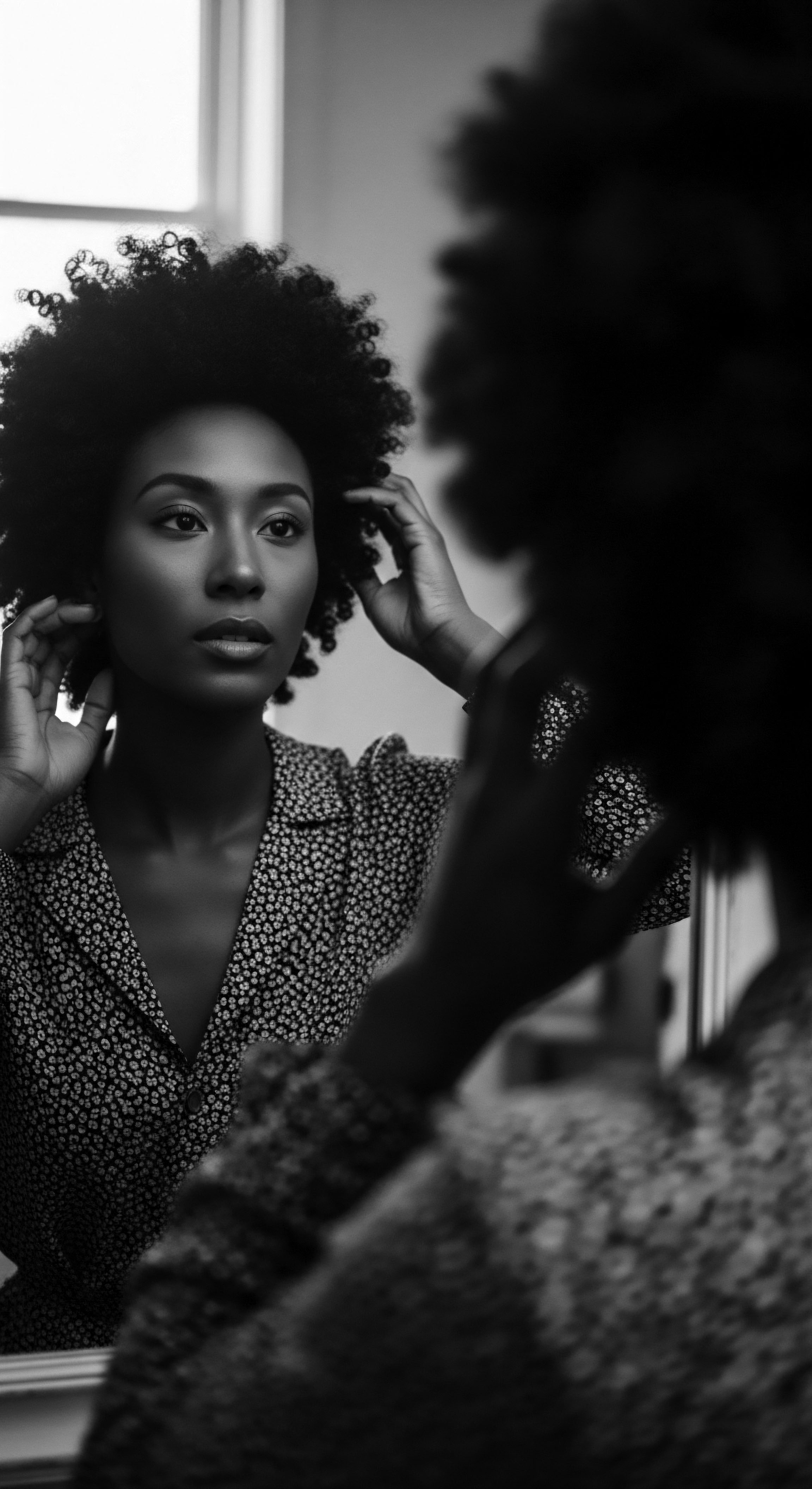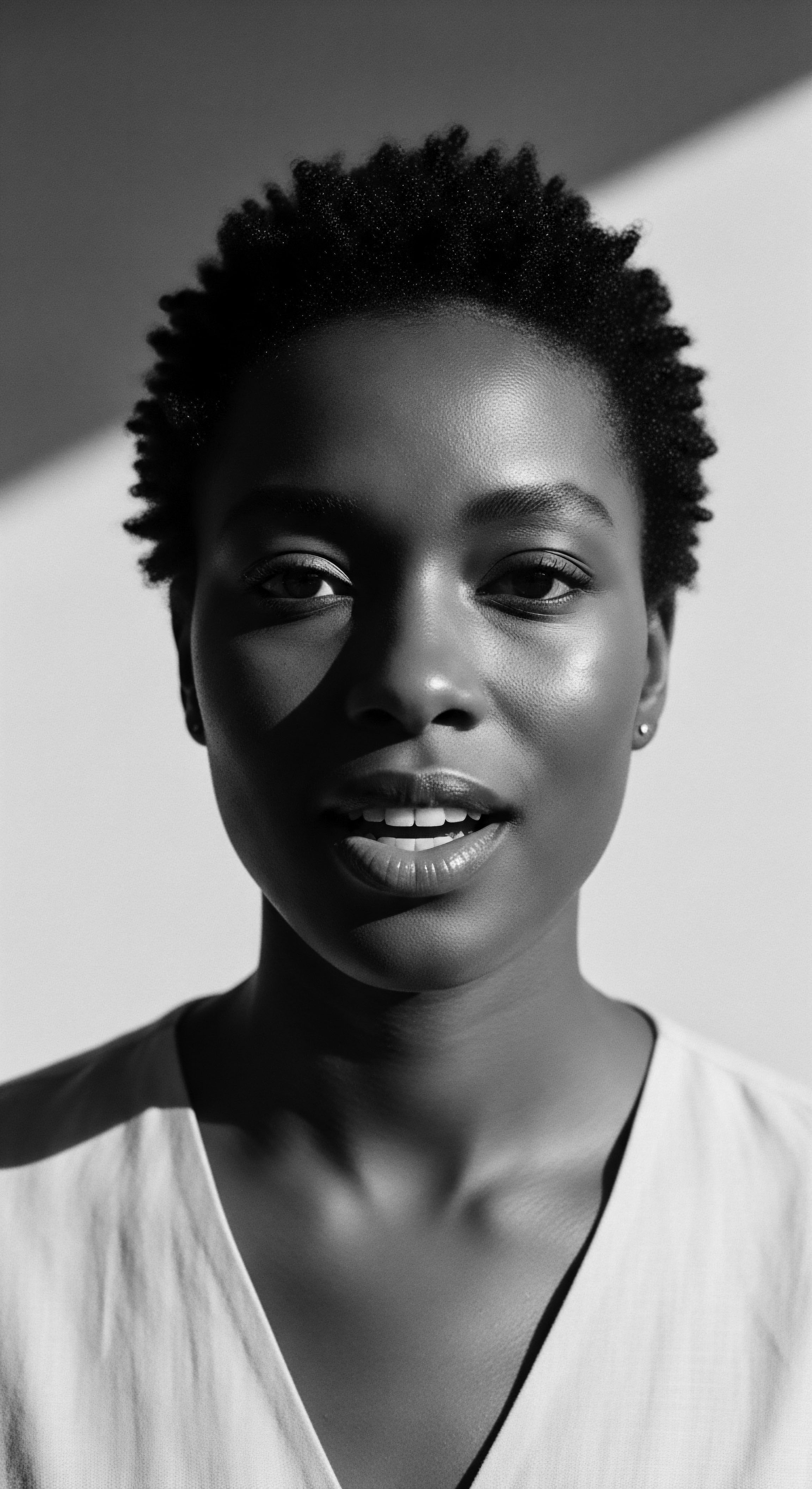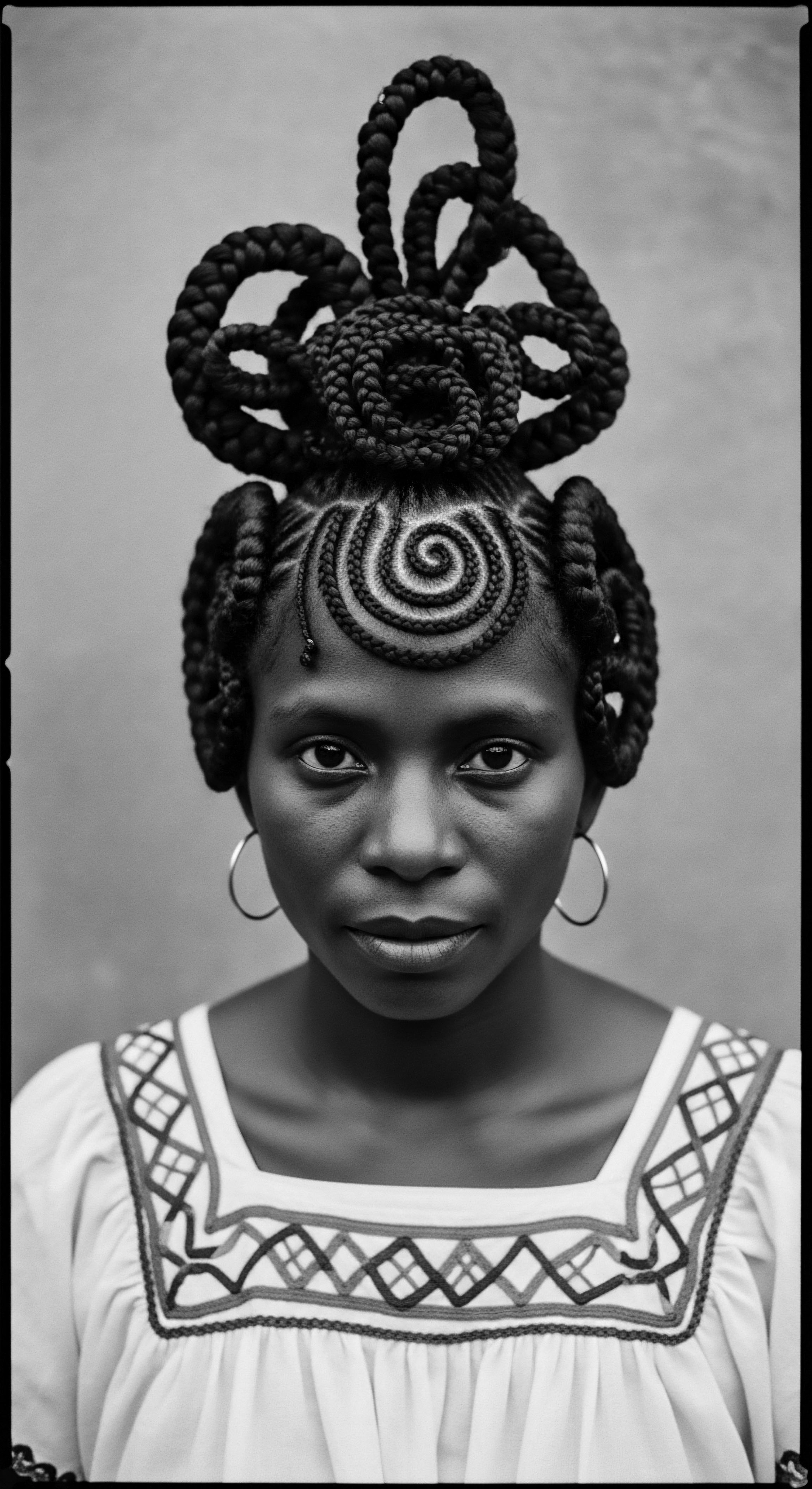
Fundamentals
The Greenwood District, often referred to as Black Wall Street, signifies more than a mere geographical area in Tulsa, Oklahoma; it represents a vibrant crucible of Black self-determination, communal fortitude, and entrepreneurial ingenuity that flourished despite the pervasive systemic injustices of the early 20th century. Its meaning extends far beyond brick-and-mortar structures. It embodies a profound testament to the resilience of the human spirit, a testament particularly resonant within the context of textured hair heritage.
This historical area, carved out from what was once Indian Territory, became a beacon for African Americans seeking refuge from the oppressive Jim Crow laws prevalent across the American South. Here, amidst segregation’s imposed boundaries, a self-sustaining economy blossomed, reflecting a defiant refusal to be limited by external constraints.
Understanding the Greenwood District’s foundation necessitates an acknowledgment of its elemental biology, the very genetic inheritance expressed in the diverse curl patterns and rich textures of Black and mixed-race hair. Hair, in its biological essence, is a protein filament, a testament to the intricate cellular architecture that forms us. Yet, for communities of African descent, hair has always been a deeper expression than simple biology. It has carried ancestral memory, coded with stories of migration, resistance, and identity.
The practice of hair care, the ritual of braiding, twisting, and adornment, stretches back to ancient African societies where hairstyles conveyed tribal affiliation, social status, marital status, and even spiritual connection. These traditions, carried across the Middle Passage in the very fibers of being, found new life and adaptation in the Americas.
The Greenwood District stands as a powerful symbol of economic self-sufficiency and communal strength, built on the bedrock of Black ingenuity and cultural pride.
In Greenwood, this heritage found a contemporary outlet. The economic self-sufficiency fostered within its boundaries extended directly to the beauty industry, giving rise to a thriving ecosystem of Black-owned beauty parlors, barbershops, and product suppliers. These establishments were not simply businesses; they served as vital social hubs, sanctuaries where individuals could receive culturally specific care, share stories, engage in political discourse, and find solace from the hostilities of the outside world. They were places where the tender thread of communal care was literally woven into the fabric of daily life through the meticulous tending of hair, offering a space for genuine connection and upliftment.

Echoes from the Source ❉ Ancestral Roots of Hair Care
Before delving deeper into Greenwood’s distinct manifestation of this heritage, it is vital to acknowledge the profound ancestral practices that shaped Black hair culture. The hair traditions brought from various African regions were far more than superficial styling; they were sophisticated systems of care, identification, and spiritual connection. In many West and West Central African societies, hair was a medium through which to communicate with gods and spirits, signifying a deep reverence for the crown. Methods such as intricate cornrows, threading, and braiding, often adorned with cowrie shells, beads, or natural pigments, denoted age, status, and even one’s family lineage.
The knowledge of natural ingredients—like shea butter, coconut oil, and various herbs—used to nourish and protect textured hair, was passed down through generations. This deep understanding of hair’s inherent nature and its needs, rooted in the earth’s bounty, formed the foundational wisdom that survived the harrowing displacement of the transatlantic slave trade.
- Braiding Traditions ❉ In pre-colonial Africa, braiding was a communal activity, strengthening familial and societal bonds while preserving cultural identity through intricate patterns that conveyed complex messages.
- Natural Ingredients ❉ Ancestral wisdom utilized natural butters, oils, and plant extracts, such as shea butter and aloe vera, prioritizing moisture retention and scalp health for diverse hair textures.
- Hair as Identity Marker ❉ Across many African cultures, hair indicated social standing, marital status, tribal affiliation, and spiritual connection, acting as a visual language within communities.
Even amidst the horrors of enslavement, the determination to preserve these practices persisted. Hair was sometimes shaved by enslavers as a means of control and cultural erasure, yet braiding continued as a quiet, powerful act of resistance and a way to retain ancestral identity. Stories even persist of rice seeds being braided into hair for survival during forced migration, highlighting the profound ingenuity and connection to heritage embedded within these practices. This historical context is not peripheral to Greenwood’s story; it is the very wellspring from which the district’s vibrant hair culture emerged, a continuation of a legacy of self-care and communal affirmation.

Intermediate
The Greenwood District’s emergence as a self-sufficient Black metropolis at the turn of the 20th century represents a profound act of collective agency, particularly for a populace largely excluded from mainstream economic and social structures by discriminatory Jim Crow laws. This separation, rather than stifling ambition, inadvertently created a fertile ground for an insulated economy where dollars circulated within the Black community, fostering wealth and opportunity. Within this dynamic environment, the hair care industry flourished with remarkable vigor, becoming a central pillar of Greenwood’s economic independence and a deeply intertwined aspect of its cultural expression. The very definition of Greenwood, then, is inextricably linked to this resourceful, inward-looking economic strategy.
The significance of beauty salons and barbershops within Greenwood extended far beyond commercial transactions. These establishments functioned as critical social infrastructure, serving as places where Black men and women could gather, share information, organize, and find community without the constant threat of white surveillance or hostility. They were hubs of intellectual exchange and political organizing, often operating below the radar of white authorities.
Indeed, scholars highlight that beauty salons in the Jim Crow South served as “asylums” for Black women, providing sanctuary from the daily indignities of segregation and functioning as incubators for Black women’s leadership. This reality underscores the deep meaning embedded in these spaces ❉ they were not merely places for aesthetic transformation but sites of profound psychological and communal sustenance.
Beauty salons and barbershops in Greenwood were foundational to the district’s economic autonomy and served as crucial social sanctuaries amidst pervasive segregation.

The Tender Thread ❉ Hair Care as Economic and Social Weaving
The success of Greenwood’s beauty sector was exemplified by entrepreneurs such as Mabel B. Little, a figure whose journey powerfully illuminates the district’s connection to hair heritage and Black enterprise. Arriving in Tulsa in 1913 with minimal resources, Little, a mere 17 years old, began working tirelessly to save for her own business. By 1917, her vision materialized as the Little Rose Beauty Salon at 615 E.
Indiana Avenue. This salon rapidly became an integral part of the community, offering specialized care, including the Taylor System hairdressing technique, which catered specifically to textured hair.
The popularity of places like Little Rose Beauty Salon demonstrates the deep demand for culturally attuned hair care services. Thursdays, often referred to as “Maid’s Night Out,” would see the salon bustling with Black women, many of whom worked in the homes of affluent white families, seeking moments of self-care and communal affirmation. These weekly rituals were not just about personal grooming; they provided a vital opportunity for women to shed the weight of their domestic labor, reconnect with their community, and affirm their inherent beauty. The salon became a space where cultural identity was openly celebrated and reinforced through shared experiences and meticulous care of Black hair.
| Establishment Type Beauty Salons |
| Community Role Provided specialized hair and beauty services for Black women; served as social hubs, meeting places, and safe havens from racial discrimination. |
| Heritage Connection Maintained traditional hair care practices, adapted them to the American context, and fostered self-acceptance of diverse hair textures. |
| Establishment Type Barbershops |
| Community Role Offered grooming services for Black men; functioned as political discussion forums, centers for community news, and places of masculine camaraderie. |
| Heritage Connection Continued the ancestral significance of hair as a marker of identity and status, creating spaces for Black men to assert their presence and dignity. |
| Establishment Type Beauty Supply Stores |
| Community Role Provided products tailored for Black hair, circumventing dependence on white-owned businesses that often neglected these specific needs. |
| Heritage Connection Facilitated access to ingredients and tools that honored and supported the unique biology and historical styling of textured hair. |
| Establishment Type These establishments were not mere commercial venues; they were foundational to the communal and economic autonomy that defined Greenwood’s prosperity and its profound cultural significance. |
The proliferation of these businesses highlights a significant aspect of Greenwood’s unique economic model. Historians and economists estimate that a dollar circulated up to 19 times within Greenwood before it exited the community. This economic self-sufficiency was a direct response to, and a powerful subversion of, racial segregation, creating a closed market system that defied external limitations.
The success of Black entrepreneurs in the beauty industry, like Mabel B. Little, did not merely generate personal wealth; it contributed directly to the district’s collective prosperity, allowing for reinvestment within the community and further solidifying its economic autonomy.
The very existence of multiple beauty establishments—Greenwood was home to numerous beauty salons and barbershops—demonstrates a recognition of the significant cultural and economic value of hair care within the Black community. This was a direct legacy of the traditions that valued hair as a central aspect of self and communal identity, adapting ancient practices to a modern context while asserting economic independence. The act of caring for textured hair, in this setting, became an act of defiance, a statement of self-worth, and a tangible contribution to collective advancement.

Academic
The Greenwood District’s meaning, at its academic and scholarly core, represents an extraordinary case study in economic nationalism and cultural preservation, specifically within the draconian confines of systemic American racism. It stands as a testament to the remarkable human capacity for collective agency and community building, born from necessity yet flourishing through ingenuity and an unwavering commitment to self-determination. The analytical lens applied to Greenwood must extend beyond conventional economic models, delving into its profound socio-cultural dynamics, particularly the ways in which everyday practices, such as hair care, became codified acts of resistance and identity affirmation. Its existence underscores the complex interplay between externally imposed constraints and internally generated resilience, revealing how marginalized communities can forge spaces of radical prosperity and cultural flourishing.
The academic understanding of Greenwood cannot be divorced from the broader historical trajectory of Black beauty culture in the United States, a narrative intrinsically linked to ancestral practices and the evolving Black experience. From the forced negation of African hair traditions during enslavement, designed to strip individuals of their cultural moorings, to the subsequent adoption of Eurocentric beauty standards as a survival mechanism in a white-dominated society, Black hair has always been a contested terrain. Yet, within this struggle, Black entrepreneurs, particularly women, carved out an autonomous industry that simultaneously provided essential services, fostered economic independence, and served as critical sites for community organizing and political activism. This historical precedent provides the bedrock for comprehending Greenwood’s distinct and highly successful beauty industry.
Greenwood’s beauty industry provides an unparalleled academic lens into how Black women, through entrepreneurship and hair care, forged economic autonomy and cultural resilience in the face of systemic racial oppression.

Textured Hair and Economic Sovereignty ❉ A Case Study from Greenwood
A rigorous examination of Greenwood District History reveals that the thriving Black-owned beauty sector was not merely a convenient commercial arrangement; it was a strategically crucial component of the district’s economic sovereignty and cultural integrity. This self-contained economic system, often referred to as “buying Black,” ensured that wealth generated within the community recirculated, strengthening its financial foundations. Beauty salons, barber shops, and product manufacturers were not peripheral businesses; they were central to the social fabric and the economic circulatory system of Greenwood.
A particularly compelling case study is the role of Mabel B. Little and her Little Rose Beauty Salon. While the impact of national figures like Madam C.J. Walker on Black beauty culture is widely acknowledged, Little’s story provides a micro-level, yet powerful, illustration of the principles at play within Greenwood.
Little, arriving in Tulsa with minimal capital, channeled the prevailing entrepreneurial spirit to establish her salon. Her success was rooted in fulfilling a specific and underserved market demand ❉ culturally appropriate hair care for Black women. Mainstream white-owned establishments largely ignored or mishandled textured hair, creating a significant void that Black beauticians were uniquely positioned to fill. This specialization was not just about profit; it was about dignity and identity.
Little’s salon, along with numerous others, operated as vital community spaces. As noted by scholars such as Tiffany Gill in her work on Black women’s activism in the beauty industry, these salons were not just places for aesthetic services; they were platforms for political discussion, information dissemination, and community organizing, often under the guise of casual conversation. This subversive nature allowed Black women to gather, strategize, and build solidarity, away from the watchful eyes of the oppressive white society.
The salons provided economic autonomy for Black women in an era when their employment opportunities were largely restricted to domestic service. By creating their own businesses, Black women could escape direct white supervision, gain financial independence, and contribute directly to their community’s wealth.
Consider the following aspects of this unique economic and social phenomenon within Greenwood:
- Economic Multiplier Effect ❉ The Black dollars spent in businesses like Little Rose Beauty Salon were reinvested within Greenwood, funding other Black-owned enterprises, real estate, and social services. This localized wealth generation was a direct counter to the exploitative external economy.
- Entrepreneurial Training Ground ❉ The beauty industry provided a accessible avenue for Black women to become entrepreneurs, learn business acumen, and manage their own ventures, creating a class of economically self-sufficient women.
- Cultural Affirmation ❉ The provision of specialized care for textured hair actively countered Eurocentric beauty standards that often denigrated Black hair, fostering self-acceptance and celebrating Black aesthetic traditions. These salons became spaces where the natural diversity of Black hair was understood, honored, and styled with expertise.
- Social and Political Nexus ❉ Beyond commerce, these establishments served as informal community centers where vital information was exchanged, political discussions took place, and strategies for racial uplift were formulated. They were crucial for maintaining communal cohesion and intellectual vibrancy.
The economic impact of the beauty industry within Greenwood, though challenging to quantify with precise granular statistics due to the 1921 massacre that destroyed most records, is profoundly demonstrated by the sheer number of beauty-related businesses and professionals documented. The Tulsa Library notes that in 1921, the Greenwood District contained 108 Black-owned businesses, including various service providers. Within the broader category of “service workers,” there were 12 barbers, and numerous salons are specifically mentioned as thriving. This density of hair-focused businesses within a relatively small geographical area speaks volumes to their economic viability and community essentiality.
The success of entrepreneurs like Mabel B. Little, who not only ran a thriving salon but also invested in rental property and co-owned a restaurant, exemplifies the multi-faceted economic growth that emanated from the beauty sector. This interconnectedness, where success in one area fueled growth in others, created a robust internal economy.

The Unbound Helix ❉ Shaping Futures Through Heritage and Innovation
The Greenwood District, prior to its tragic destruction in 1921, embodied an aspirational future where Black communities could exercise complete economic and cultural autonomy. The beauty industry, rooted deeply in ancestral hair practices and adapted to modern needs, stood as a powerful symbol of this potential. The very act of caring for textured hair, often deemed problematic or “unruly” by dominant white society, became a revolutionary statement of self-acceptance and pride within Greenwood. This was a localized manifestation of a broader movement, prefiguring the natural hair movements of later decades.
The legacy of Greenwood informs current discussions about Black economic empowerment and cultural revitalization. Contemporary efforts to support Black-owned businesses, to invest in underserved communities, and to celebrate diverse hair textures are direct echoes of Greenwood’s foundational principles. The district’s history provides invaluable insights into the power of collective economics and the inherent strength found in cultural self-reliance. Its meaning reverberates in the ongoing efforts to reclaim narratives, foster intergenerational wealth, and assert the inherent beauty of Black identity.
The enduring significance of Greenwood District History, especially regarding hair heritage, extends into how we approach textured hair science today. Modern scientific understanding often validates the empirical wisdom of ancestral practices. For example, the emphasis on moisture retention and scalp health, central to traditional African hair care, is now affirmed by dermatological research on the unique structural properties of coily and curly hair strands. The science of the Greenwood experience lies in the implicit understanding that catering to specific hair needs was not a luxury, but a necessity for health and well-being, both physical and psychological.
Looking at the tragic destruction of Greenwood in 1921, and its subsequent rebuilding efforts, provides another layer of understanding. Despite the devastation, which saw businesses and homes burned to the ground, Greenwood residents demonstrated remarkable resilience, rebuilding many businesses, including beauty salons, relatively quickly. This act of rebuilding was not merely economic recovery; it was an act of cultural and spiritual restoration, a determination to resurrect the physical manifestations of their self-worth and communal ties. The hair salons and barbershops that re-emerged were powerful symbols of this enduring spirit, providing familiarity and a return to cherished rituals of care and connection in the wake of unimaginable loss.

Reflection on the Heritage of Greenwood District History
The legacy of the Greenwood District, though scarred by unspeakable violence, stands as an enduring testament to the boundless spirit of a people determined to define their own destiny, particularly as it pertains to the very Soul of a Strand. Its profound meaning is not confined to the annals of economic history; rather, it pulses within the vibrant current of Black hair heritage, whispering lessons of resilience, resourcefulness, and radical self-love. The very act of cultivating beauty, of tending to textured hair within Greenwood’s embrace, was a sacred ritual, a living archive of ancestral wisdom passed through generations. It was a defiant declaration that Black beauty, in its authentic and diverse forms, was worthy of meticulous care and profound reverence.
The echoes of Greenwood resonate whenever a hand reaches to braid, twist, or nurture a coiled strand, whenever natural ingredients are sought for their inherent goodness, whenever a salon chair becomes a sanctuary for communal sharing. This historical narrative reminds us that hair is never merely an aesthetic choice; it is a profound connection to lineage, a visible manifestation of identity forged in the crucible of both joy and struggle. The district’s journey from elemental biology, through the tender threads of living traditions, to its role in voicing identity and shaping futures, offers an everlasting wellspring of inspiration.
It compels us to remember that true wellness extends beyond the physical, embracing the historical, the cultural, and the deeply spiritual aspects of our being. The vibrant legacy of Greenwood continues to illuminate our understanding of hair as an unbound helix, ever twisting, ever evolving, yet forever rooted in the rich soil of ancestral wisdom.

References
- Gates, E. F. (2003). Riot on Greenwood ❉ The Total Destruction of Black Wall Street. Illustrated ed. Trax Publishing.
- Johnson, H. B. (2009). Black Wall Street ❉ From Riot to Renaissance in Tulsa’s Historic Greenwood District. Eakin Press.
- Gill, T. M. (2010). Beauty Shop Politics ❉ African American Women’s Activism in the Beauty Industry. University of Illinois Press.
- Bundles, A’L. (2001). On Her Own Ground ❉ The Life and Times of Madam C.J. Walker. Scribner.
- Byrd, A. D. & Tharps, L. R. (2014). Hair Story ❉ Untangling the Roots of Black Hair in America. St. Martin’s Press.
- Roberts, C. (2013). Pageants, Parlors, and Politics ❉ Race and the Beauty Industry in the Twentieth-Century South. University of North Carolina Press.
- Wilkins, R. (2009). The Souls of Black Folk. Dover Publications.
- Patton, D. (2006). African-American Hair ❉ An Exploration of Culture, Politics, and Identity. Peter Lang Publishing.
- Morgan, G. J. (2008). The Hair Culture of African American Women. University Press of Mississippi.
- Boyd, H. (2009). African American Hair ❉ A Cultural History. The Rosen Publishing Group.
